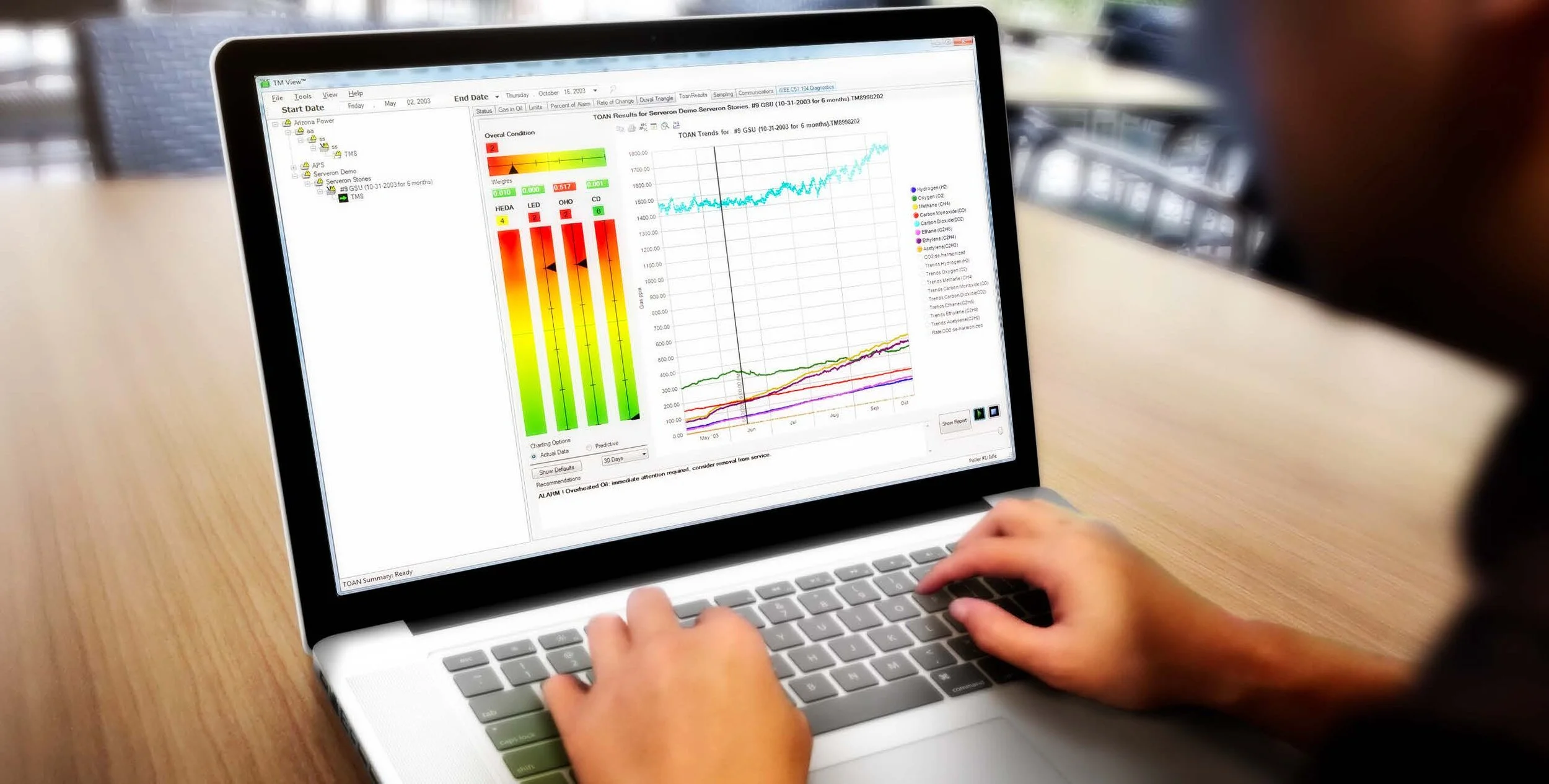In the last several decades, there has been a notable change in the way transformers are viewed. Their importance together with their obvious value to the network has been recognised.
Against this backdrop, the advent of transformer monitoring has emerged and continues to develop at a rapid pace. Now firmly established as a mainstay of power transformer monitoring, online Dissolved Gas Analysis (DGA) is one of the most powerful tools in protecting against unexpected asset failures.

The need for Expert Analysis
Prior to the emergence of online DGA monitoring, the traditional technique was manual sampling and laboratory DGA.
As online DGA monitors have evolved, new technologies are reaching the market at an ever-increasing rate. However, the quiet revolution is in the analysis of the data coming from the monitor. Whereas traditionally, a laboratory DGA report would be accompanied by recommendations and expert analysis, this same facility is not inherent with an online monitor.
As more and more monitors are installed, the burden of data analysis becomes increasingly large and falls on the asset management team to diagnose. Yet, there are fewer specialists with deep subject matter expertise in the industry.

Increased reliance on software
Innovative ways of extracting value from this data are required and are now being integrated into software platforms accompanying monitors.
One important approach is the use of Artificial Neural Networks (ANN) for DGA data analysis.
Additionally, traditional ratio-based diagnostic tools, such as the Duval Triangle, have evolved with the addition of more refined triangles and a concise set of pentagons.
It is important to understand, however, that the key element of online DGA is not the technology used or the specifications of the device, but rather the user’s ability to formulate meaningful information from the DGA results. Today, this is generally provided by software platforms from device manufacturers, such as Serveron’s TM View™ software suite. The analytics within TM View can be broken down into two categories: traditional, ratio-based diagnostics and advanced neural network algorithms.
ANN Enhanced Diagnostics
Artificial Neural Networks are a computational model based on the structure of the human brain and have been used for over 50 years in weather and stock forecasting as well as process controls.
ANNs are excellent classifiers for use in pattern recognition tasks where the relationship between input and output is complex and so are well suited to “big data” analytical problems.
The only commercially available example of an ANN being employed for DGA is found in TOAN (Transformer Oil Analysis and Notification). Originally developed by Arizona Public Service (APS) company, TOAN is now available to users of Serveron multi-gas online DGA equipment in the form of a plug-in within Serveron’s TM View™ software suite.
The need for exception-based reporting
The development of TOAN stemmed from the fact that APS has over 170 Serveron 8-gas monitors on their most critical transformers. Each monitor was set to sample the transformer oil every 4 hours, reporting data on individual gas concentrations for Carbon Monoxide (CO), Carbon Dioxide (CO₂), Hydrogen (H₂), Methane (CH₄), Ethane (C₂H₆), Ethylene(C₂H₄), Acetylene(C₂H²), Oxygen(O₂).
The volume of data obtained from these monitors was huge, at over 350,000 samples annually with most of the data being repetitive. APS considered that what they needed was to develop an analysis engine employing highly accurate algorithms that would also allow them to incorporate an exception-based reporting system. This system would only alarm on real faults, without any need for an individual to review large volumes of data.

Identifying critical fault conditions
APS identified four fault conditions that should trigger investigation: Over Heating (OH), Low Energy Discharge or arcing (LED), High Energy Discharge or Arcing (HEDA) and Cellulose Decomposition(CD). Further investigation indicated that not only could the type of fault be identified, but an accurate scale of severity could be employed to define whether immediate action is required at any given time. To this end the ANN was expanded to define a severity of fault between 1 and 6, where 1 is most severe. Added to that was a notification engine to generate messaging appropriate for the severity of fault. Finally, the incorporation of Piecewise Linear Approximation (PLA) and harmonic regression improved the efficiency of the algorithms by eliminating the harmonic effects of time, temperature and transformer loading on gas generation.
The results
For each fault condition, APS achieved successful fault identification 97.6% or higher. The key to TOANs success rate lies in the power of the ANN and the database used to train the system.
In the form of TOAN, asset managers have a powerful new tool for managing large volumes of DGA. The availability of TOAN as a tool for automated DGA analysis represents one of the most significant changes in DGA diagnostics in the last decade.
While Duval and others continue to expand and improve ratio-based methods that, in the right hands, are powerful and effective, alarming on faults - not ppm - is more appropriate where in-house expertise is not available. Apart from the ability to identify a specific fault condition, the prospects of being able to handle large populations of online monitors automatically make ANNs and, in this case, TOAN, a step change in DGA analytics.
